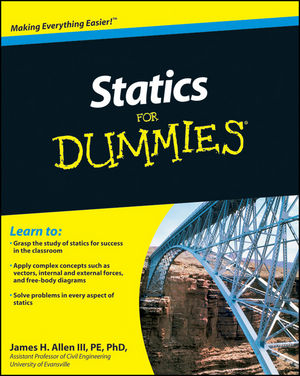Statics For DummiesISBN: 978-0-470-59894-8
Paperback
384 pages
September 2010
 |
||||||
Introduction 1
Part I: Setting the Stage for Statics 7
Chapter 1: Using Statics to Describe the World around You 9
Chapter 2: A Quick Mathematics Refresher 17
Chapter 3: Working with Unit Systems and Constants 31
Part II: Your Statics Foundation: Vector Basics 39
Chapter 4: Viewing the World through Vectors 41
Chapter 5: Using Vectors to Better Defi ne Direction 51
Chapter 6: Vector Mathematics and Identities 69
Chapter 7: Turning Multiple Vectors into a Single Vector Resultant 79
Chapter 8: Breaking Down a Vector into Components 95
Part III: Forces and Moments as Vectors 107
Chapter 9: Applying Concentrated Forces and External Point Loads 109
Chapter 10: Spreading It Out: Understanding Distributed Loads 123
Chapter 11: Finding the Centers of Objects and Regions 135
Chapter 12: Special Occasions in the Life of a Force Vector: Moments and Couples 149
Part IV: A Picture Is Worth a Thousand Words (Or At Least a Few Equations): Free-Body Diagrams 167
Chapter 13: Anatomy of a Free-Body Diagram 169
Chapter 14: The F.B.D.: Knowing What to Draw and How to Draw It 185
Chapter 15: Simplifying a Free-Body Diagram 199
Part V: A Question of Balance: Equilibrium 207
Chapter 16: Mr. Newton Has Entered the Building: The Basics of Equilibrium 209
Chapter 17: Taking a Closer Look at Two-Dimensional Equilibrium: Scalar Methods 219
Chapter 18: Getting Better Acquainted with Three-Dimensional Equilibrium: Vector Methods 229
Part VI: Statics in Action 241
Chapter 19: Working with Trusses 243
Chapter 20: Analyzing Beams and Bending Members 259
Chapter 21: Working with Frames and Machines 279
Chapter 22: A Different Kind of Axial System: Cable Systems 293
Chapter 23: Those Darn Dam Problems: Submerged Surfaces 309
Chapter 24: Incorporating Friction into Your Applications 321
Part VII: The Part of Tens 339
Chapter 25: Ten Steps to Solving Any Statics Problem 341
Chapter 26: Ten Tips for Surviving a Statics Exam 347
Index 353



